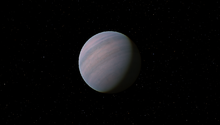A team of astronomers led by Stéphane Udry of the Geneva Observatory used the HARPS instrument on the European Southern Observatory 3.6 meter telescope in La Silla, Chile to discover the planet in 2007. Udry's team employed the radial velocity technique, in which the size and mass of a planet are determined based on the small perturbations it induces in its parent star’s orbit via gravity.[3]
The motion of the parent star indicates a minimum mass for Gliese 581 d of 7.09 Earth masses. Dynamical simulations of the Gliese 581 system assuming that the orbits of the three planets are coplanar show that the system becomes unstable if the masses of the planets exceed 1.6 – 2 times the minimum values. This implies an upper mass limit for Gliese 581 d of 13.8 Earth masses.[2]
Climate and habitability
It was originally thought that Gliese 581 d orbits outside the habitable zone of its star. However, in 2009 the original discovery team revised its original estimate of the planet's orbital parameters, finding that it orbits closer to its star than originally believed. They concluded that the planet is within the habitable zone where liquid water could exist. [2][4] According to Stéphane Udry, "It could be covered by a 'large and deep ocean'; it is the first serious ocean planet candidate."[5][dead link]

On average, the light that Gliese 581 d receives from its star has about 30% of the intensity of sunlight on Earth. By comparison, sunlight on Mars has about 40% of the intensity of that on Earth. That might seem to suggest that Gliese 581 d is too cold to support liquid water and hence is inhospitable to life. However, an atmospheric greenhouse effect can significantly raise planetary temperatures. For example, Earth's own temperature would be about -18°C[6] without any greenhouse gases. If the atmosphere of Gliese 581 d produces a sufficiently large greenhouse effect, then the surface temperature might well permit liquid water and the planet might conceivably support life.[7][8][9]
Gliese 581 d is probably too massive to be made only of rocky material, but it is speculated that it is an icy planet that has migrated closer to the star.[10][11] Calculations by Barnes et al. suggest, however, that tidal heating is too low to keep plate tectonics active on the planet, unless radiogenic heating is somewhat higher than expected.[12]
[edit] Messages from Earth

In October 2008, members of the networking website Bebo beamed A Message From Earth, a high-power transmission at Gliese 581, using the RT-70 radio telescope belonging to the National Space Agency of Ukraine. This transmission is due to arrive in the Gliese 581 system's vicinity by the year 2029; the earliest possible arrival for a response, should there be one, would be in 2049.[13]
As part of the 2009 National Science Week celebrations in Australia, Cosmos Magazine launched a website called Hello From Earth to collect messages for transmission to Gliese 581d. The maximum length of the messages was 160 characters, and they were restricted to the English language. In total, 25,880 messages were collected from 195 countries around the world. The messages were transmitted from the DSS-43 70 m radio telescope at the Canberra Deep Space Communication Complex at Tidbinbilla, Australia on the 28th of August, 2009.[14]
No comments:
Post a Comment